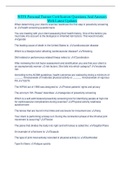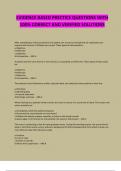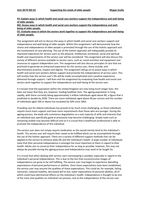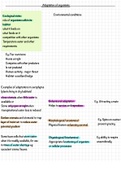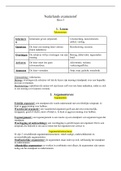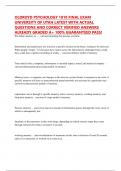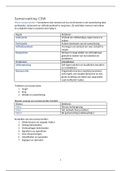University of Venda
DEPARTMENT OF BIOLOGICAL SCIENCES
Animal Physiology
ZOO 2541
Study Guide
2024
,ZOO 2541: Animal Physiology About This Module
1. Aims of this module
The aim of this module is to provide you with an overview of the study area of animal physiology and to
introduce you to the principles of this field that underlie all animals. It provides a comprehensive outline
of physiological systems in a well-organized and concise manner by moving between description of general
principles of physiology and specific examples of these principles from a variety of animal species. It starts
with essential chemical and physical laws that govern physiological processes in animals (unifying themes
in physiology). These provide a foundation to understand the breadth of physiology. The module illustrates
how the major physiological systems function and integrate to sustain the lives of animals.
2. Learning outcomes
- Develop critical thinking skills and be able to apply physiological concepts and principles at the basic and
applied levels.
- Develop a working knowledge of the major physiological systems and be able to associate anatomical areas
with their specific function.
- Develop an understanding of the role of evolutionary processes (e.g. natural selection) in driving the
organization of physiological systems.
- Understand important physiological challenges animals face, how those challenges vary in relation to the
animals’ environment, and the processes by which animals deal with these challenges.
- Identify and describe structural differences of major physiological systems that characterize different
taxonomic groups of animals.
- Relate physiological processes, from the biochemical to the system level, to the function of the entire
organism in its environment.
- Learn to properly and safely use animals and modern laboratory equipment to conduct physiological
research
3. Contents
- Fundamentals of Physiology
- Cell physiology
- Gas exchange
- Osmoregulation and excretion
- Communication
- Movement
4. Assessments
a. Formative assessments:
- Assignments weight (20%)
- Practical reports weight (20%)
- Class tests weight (60%)
2
,b. Summative assessment:
- Examination weight (40%)
5. Semester mark weight (60%)
6. Textbooks
CAMPBELL, N.A; Reece, J.B; Urry, L.A; Cain, M.C; Wasserman, S.A; Minorsky, P.V; & Jackson, R.B.
2015. Biology. A Global Approach. 10th edition. Publishers, Pearson Education Limited. UK. 1351pp.
(570 BIO)
GORDON, M. S. 1982. Animal Physiology: Principles & Adaptation. (591.1 GOR)
HAINSWORTH, F. R. 1981. Animal Physiology: Adaptation & Functions. (591.1 HAI)
WILLMER, P.; Stone, G. & Johnstone I. 2005. Environmental Physiology of Animals. 2nd edition.
Blackwell Publishing Company’s. (571.1 WIL)
RANDALL, D. J. 2002. Eckert animal physiology: mechanisms and adaptation. (571.1 RAN)
SCHMIDT-NIELSEN, K. 2002 Animal Physiology - Adaptation and Environment. 5th Edition, University
Press, Cambridge, pp. 612.
SHERWOOD, L; Klandorf, H; & Yancey, P.H. 2005. Animal Physiology. From Genes to Organisms.
Thomson Brooks/Cole Publishers. USA. pp759. (571.1 SHE)
SOLOMON, E.P; BERG, L.R & MARTIN, D.W. 2019. Biology. 11th ed. Publisher Brooks/Cole Cengage
Learning. USA (570 SOL).
7. Lecture venue
A8
8. Lecture Periods
Wednesday: 11H00
Thursday: 12H00 – 13H50
9. Formative Assessments
- Assignment number 1: Due date 8 March 2024 (Turnitin)
- Assignment number 2: Due date 24 April 2024 (Turnitin)
- Test number 1: 09 March 2024 (9H00, venue to be announced)
- Test number 2: 04 May 2024 (9H00, venue to be announced)
10. Course presenter
- Ms MF Seshoka
- Email:
- Office: FF050 Life Science Building
- Consultation sessions: Monday – Thursday 15h00 -16H30
3
, ZOO 2541: Animal Physiology Module Outline
Unit 1: Fundamentals of Physiology
- What is Physiology?
- The importance of Physiology
- Central themes in animal Physiology
- Homeostasis
Unit 2: Cellular Physiology
- Introduction
- Cellular organization and function
- Transport across membranes
▪ Passive transport (simple diffusion, facilitated diffusion, osmosis)
▪ Active transport (primary & secondary active transport, vesicular transport)
- Bioenergetics
▪ Energy
▪ The Laws of thermodynamics
▪ Free energy, exergonic and endergonic reactions
▪ Cell energy: ATP and coupled reactions, enzymes, activation energy
▪ Mechanisms of ATP Production: Energy-Releasing Metabolic Pathways
Unit 3: Gas Exchange
- Introduction
- Basic principles of gas exchange
- Gas diffusion
- Air and water as respiratory media
- Respiratory surfaces
- Mechanism of gas exchange in Fish
- Mechanism of gas transport
Unit 4: Osmoregulation and Excretion
- Introduction
- Osmoregulation in animals
- Excretion of nitrogen compounds
- Regulation of Urine Concentration and Volume
Unit 5: Communication
- Introduction
- Basic principles and concepts
- Neuron: The functional unit of the nervous system
- Membrane potentials
- The resting and action potential
- Transmission across chemical synapses
Unit 6: Movement
- Introduction
- Vertebrate skeletal muscle
- Mechanism of muscle fiber contraction
4



